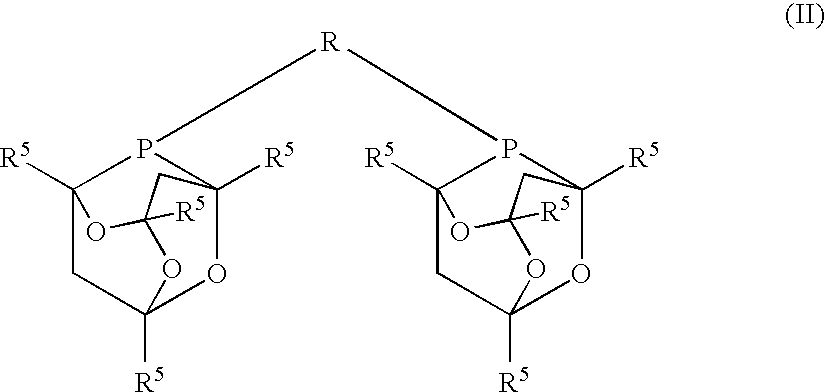Process for the carbonylation of pentenenitrile
- Summary
- Abstract
- Description
- Claims
- Application Information
AI Technical Summary
Benefits of technology
Problems solved by technology
Method used
Image
Examples
example 10
[0068]Example 1 was repeated except that 0.6 mmol of 1,3-P,P′-di(2-phospha-1,3,5,7-tetramethyl-6,9,10-trioxatricyclo[3.3.1.1{3.7}decyl)propane (DPA3) was used as the ligand in the presence of 0.5 mmol CH3SO3H, 10 ml pentenenitrile and 40 ml methanol at 115° C. The initial rate (mol / mol / hr) was 100. The conversion was 70% after 10 hours. The selectivity to cyano-esters was 98%. The linearity was 88%.
example 11
[0069]Example 1 was repeated except that the autoclave was charged with 10 ml methanol, 40 ml anisole, 20 ml of 2-pentenenitrile, 0.25 mmol palladium(II) acetate, 0.6 mmol 1,3 bis(di-tert-butylphosphino)propane and 2 mmol tert-butylsulphonic acid. The Palladium acetate / phosphine were charged under a nitrogen atmosphere. After closure of the autoclave it was evacuated, whereupon 60 bar of Co was supplied. The autoclave was heated to 125° C. The initial rate (mol / mol / hr) was 200. The conversion was 74% after 4 hours. The selectivity to cyano-esters was 98%. The linearity was 92.5%.
[0070]
initialselectivityrateto cyano-reactiontemp.(mol / conversionesterslinearityEx.Ligand (mmol)acid (mmol)medium (ml)(° C.)mol / hr)(%)(mol %)(mol %)(1)11,3 bis(di-tert-CH3SO3H (2)CH3OH (40)115200859893butylphosphino)-propane (0.6)A1,3 bis(di-iso-″″115trace——propylphoshino)-propane (0.6)21,3 bis(di-tert-″″100300949893butylphosphino)-propane (0.6)31,3 bis(di-tert-CH3SO3H (1)″100350849893butylphosphino)-propane...
PUM
| Property | Measurement | Unit |
|---|---|---|
| Temperature | aaaaa | aaaaa |
| Temperature | aaaaa | aaaaa |
| Molar ratio | aaaaa | aaaaa |
Abstract
Description
Claims
Application Information
 Login to View More
Login to View More - R&D
- Intellectual Property
- Life Sciences
- Materials
- Tech Scout
- Unparalleled Data Quality
- Higher Quality Content
- 60% Fewer Hallucinations
Browse by: Latest US Patents, China's latest patents, Technical Efficacy Thesaurus, Application Domain, Technology Topic, Popular Technical Reports.
© 2025 PatSnap. All rights reserved.Legal|Privacy policy|Modern Slavery Act Transparency Statement|Sitemap|About US| Contact US: help@patsnap.com



